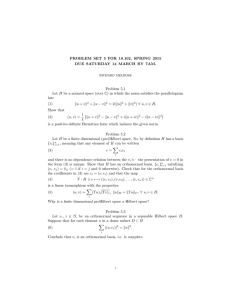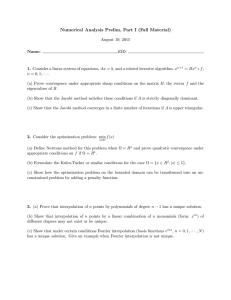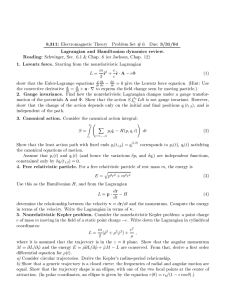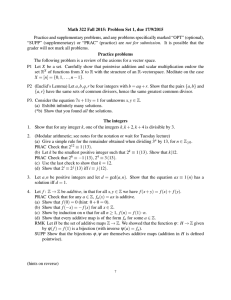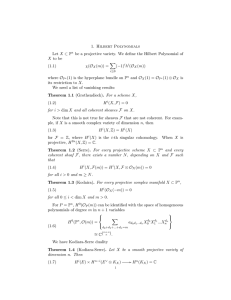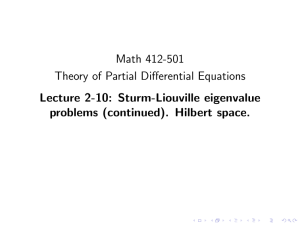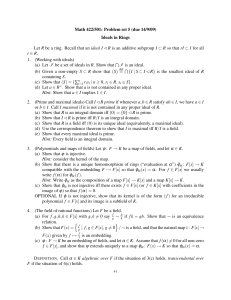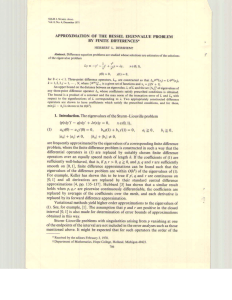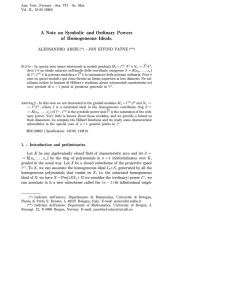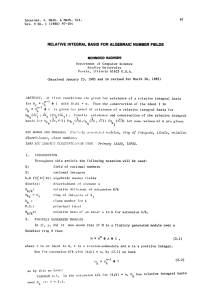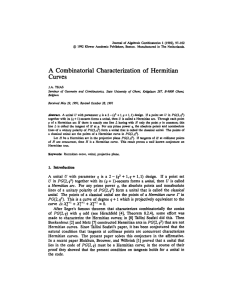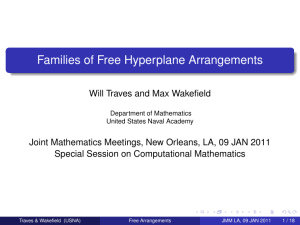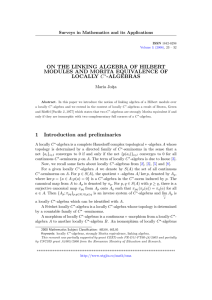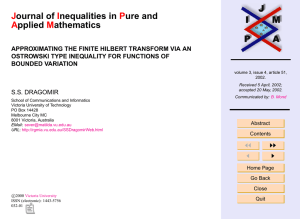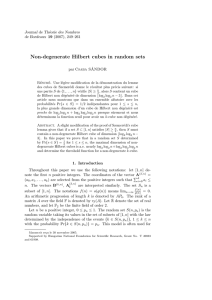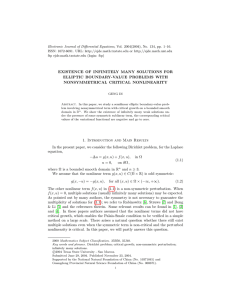PROBLEM SET 5 FOR 18.102, SPRING 2016 Problem 5.1
advertisement
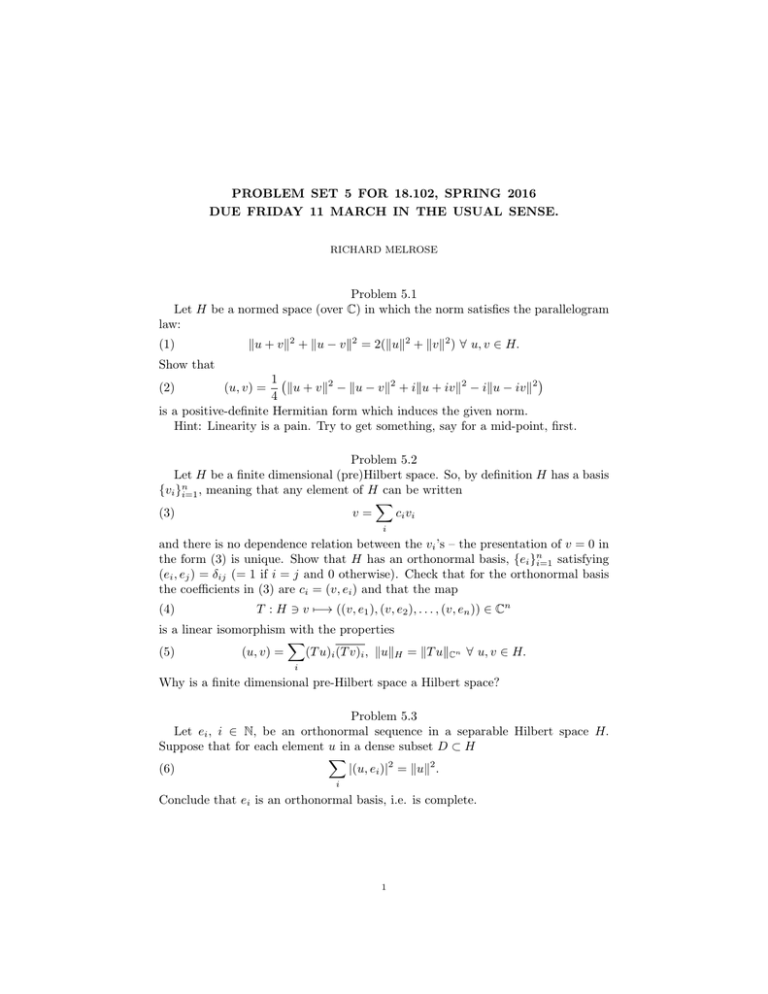
PROBLEM SET 5 FOR 18.102, SPRING 2016
DUE FRIDAY 11 MARCH IN THE USUAL SENSE.
RICHARD MELROSE
Problem 5.1
Let H be a normed space (over C) in which the norm satisfies the parallelogram
law:
(1)
ku + vk2 + ku − vk2 = 2(kuk2 + kvk2 ) ∀ u, v ∈ H.
Show that
1
ku + vk2 − ku − vk2 + iku + ivk2 − iku − ivk2
4
is a positive-definite Hermitian form which induces the given norm.
Hint: Linearity is a pain. Try to get something, say for a mid-point, first.
(2)
(u, v) =
Problem 5.2
Let H be a finite dimensional (pre)Hilbert space. So, by definition H has a basis
{vi }ni=1 , meaning that any element of H can be written
X
(3)
v=
c i vi
i
and there is no dependence relation between the vi ’s – the presentation of v = 0 in
the form (3) is unique. Show that H has an orthonormal basis, {ei }ni=1 satisfying
(ei , ej ) = δij (= 1 if i = j and 0 otherwise). Check that for the orthonormal basis
the coefficients in (3) are ci = (v, ei ) and that the map
(4)
T : H 3 v 7−→ ((v, e1 ), (v, e2 ), . . . , (v, en )) ∈ Cn
is a linear isomorphism with the properties
X
(5)
(u, v) =
(T u)i (T v)i , kukH = kT ukCn ∀ u, v ∈ H.
i
Why is a finite dimensional pre-Hilbert space a Hilbert space?
Problem 5.3
Let ei , i ∈ N, be an orthonormal sequence in a separable Hilbert space H.
Suppose that for each element u in a dense subset D ⊂ H
X
(6)
|(u, ei )|2 = kuk2 .
i
Conclude that ei is an orthonormal basis, i.e. is complete.
1
2
RICHARD MELROSE
Problem 5.4
Consider the sequence space
X
(7)
h2,1 = c : N 3 j 7−→ cj ∈ C;
(1 + j 2 )|cj |2 < ∞ .
j
(1) Show that
h2,1 × h2,1 3 (c, d) 7−→ hc, di =
(8)
X
(1 + j 2 )cj dj
j
2,1
is an Hermitian inner form which turns h into a Hilbert space.
(2) Denoting the norm on this space by k · k2,1 and the norm on l2 by k · k2 ,
show that
h2,1 ⊂ l2 , kck2 ≤ kck2,1 ∀ c ∈ h2,1 .
(9)
Problem 5.5
Suppose that H1 and H2 are two different Hilbert spaces and A : H1 −→ H2 is
a bounded linear operator. Show that there is a unique bounded linear operator
(the adjoint) A∗ : H2 −→ H1 with the property
(10)
hAu1 , u2 iH2 = hu1 , A∗ u2 iH1 ∀ u1 ∈ H1 , u2 ∈ H2 .
If v ∈ L1 (R) and
Problem 5.6 – Extra
v
=
0
for all a < b show that v is a null function.
(a,b)
R
Problem 5.7 – Extra
Consider the subspace of L2 (R) which consists of continuous functions u with
the additional property that there exists v ∈ L2 (R) such that
(
R
u(0) + (0,x) v(t) if x > 0
R
(11)
u(x) =
u(0) − (x,0) v(t) if x < 0.
Show that for a given u if there are two such functions v then they differ by a null
function. Prove that the set of pairs (u, [v]) where [v] ∈ L2 (R) is a Hilbert space
with respect to the inner product
Z
Z
(12)
h(u1 , [v1 ]), (u2 , [v2 ])i = u1 u2 + v1 v2 .
Department of Mathematics, Massachusetts Institute of Technology
E-mail address: rbm@math.mit.edu
